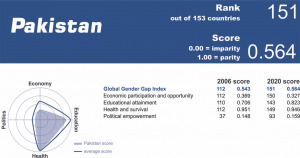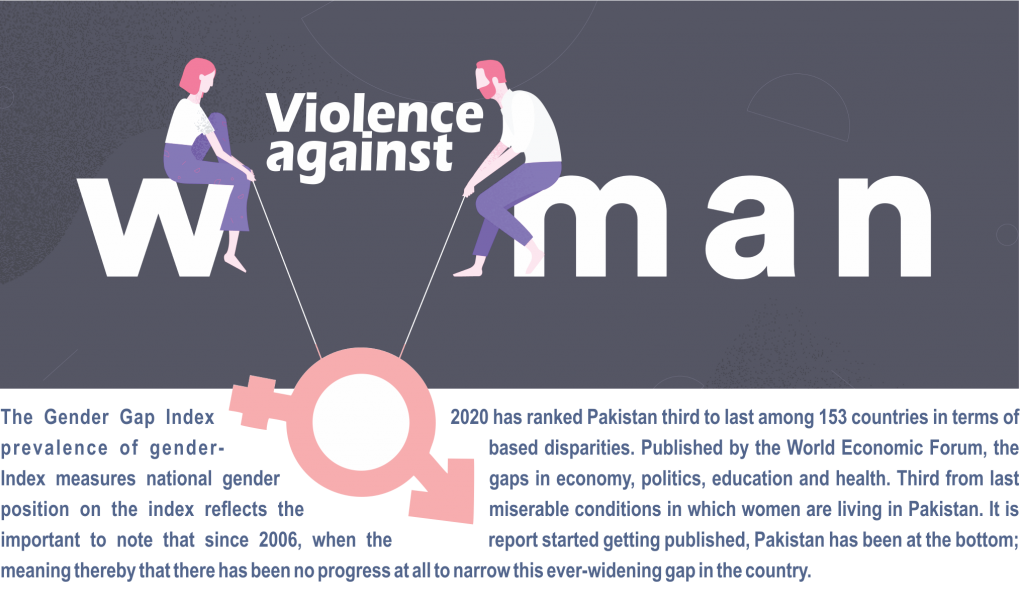Violence agaisnt Women
Gender-Based Violence (GBV) is a universal phenomenon affecting all societies in one way or the other. Almost every woman, during her lifetime, has faced discrimination or fear because of her sex. The World Health Organization estimates that at least one in every five of the world’s female population has been physically and sexually abused at some time. GBV affects both physical and emotional health of women and has far-reaching effects on society on the whole.
Women in Pakistan live in a society that is predominantly governed by strict religious, family and tribal customs. Though there is realization on the part of the government and civil society of ensuring women rights, treatment of the women remains more or less the same, and they continue to suffer because of their gender. They face various forms of violence and discrimination in almost every aspect of their life.
The number of reported cases of sexual crimes and domestic violence is on the increase. As per findings of White Ribbon Pakistan (NGO), 47,034 women faced sexual violence, over 15000 cases of honour killings were registered, 1,800 cases of domestic violence and over 5,500 kidnappings of women took place between 2014 and 2016. According to media reports, more than 51,241 cases of violence against women were reported between January 2011 and June 2017. Shockingly, the conviction rate remained abysmally low and only 2.5 percent were convicted finally by the courts. It is important to note that only 0.4 percent women take their cases to the court.
Violence against Women in Pakistan: The Latest Picture
As per the report titled ‘Violence against Women and Girls in the Time of Covid 19 Pandemic’ by Aurat Foundation, as many as 2,297 cases of violence against women (VAW) were reported in 25 districts of Pakistan in the year 2020. This was despite a challenge of under-reporting due to Covid 19. Month-to-month analysis of the data shows that at the peak of the pandemic in July, cases of VAW were the highest. Following this, the number of cases dropped again but rose in September due to the resurgence of Covid. The findings of the report show that among the total number of VAW incidents, 57 percent were reported from Punjab, 27 percent from Sindh, 8 percent from Khyber Pakhtunkhwa, 6 percent from Gilgit Baltistan, and 2 percent from Balochistan.
Of all the provinces, Punjab reported the highest incident of murder, rape, suicide, acid burning, kidnapping, domestic violence, child and forced marriage, dowry and inheritance. Sindh had the most cases of honour killing. The victims of violence, survivors of violence ranged from two years to middle age and they belonged to all socio-economic backgrounds. Violence occurred both in home and public places.Pakistan’s Profile in Gender Gap Index 2020
Pakistan ranks third-to-last (151st) on the 2020 Global Gender Gap Index, having closed only 56% of the gender gap. This performance represents an improvement from the previous edition (55.0), but it is insufficient to prevent Pakistan from falling in the rankings, as new countries have entered the rankings at a higher position. Pakistan ranks in the bottom 10 in three of the four main categories of the index and below the 100th mark in 12 of the 14 individual indicators composing the index. Encouragingly, however, Pakistan improves on a majority of them—sometimes markedly and is stable in the others. The gap remains cavernous in terms of economic participation and opportunities (32.7, 150th). Only one-quarter of women participate in the labour force (i.e. working or looking to work) compared with 85% of men (148th). Only 5% of senior and leadership roles are held by women (146th), twice the rate of 2016. It is estimated that only 18% of Pakistan’s labour income goes to women (148th), one of the lowest share among countries studied. While a majority of countries have bridged or nearly bridged the educational gender gap, Pakistan’s still stands at almost 20%. Less than half of women are literate, compared with 71% of men, while the share of women enrolled is systematically lower than the share of men across primary, secondary and tertiary education. The political gender gap has narrowed markedly over the past two years but remains wide (15.9, 93rd). In 2017, there was not a single female minister. As of 1 January 2019, there were three women in the 25-member cabinet.
According to Aurat Foundation almost 90 percent of women have experienced some form of violence at the hands of their husbands or families, 50 percent of women report that violence either increases or does not change when they are pregnant, only 0.4 percent women take their cases to the court and almost 50 percent of women who experience domestic violence and do not respond in any way and suffer silently.
 The Acid Survivors Foundation conducted a study entitled “Situational Analysis” on acid violence 2015 in collaboration with National Commission on the Status of Women. The analysis revealed that from 2007 to June 2015, there were 1,231 victims of acid violence in the country, and 1,004 acid attacks were reported. About 70 percent of the victims were women falling in the age bracket of 17-30 years. Sadly, GBV is on the rise despite different government initiatives taken recently.
The Acid Survivors Foundation conducted a study entitled “Situational Analysis” on acid violence 2015 in collaboration with National Commission on the Status of Women. The analysis revealed that from 2007 to June 2015, there were 1,231 victims of acid violence in the country, and 1,004 acid attacks were reported. About 70 percent of the victims were women falling in the age bracket of 17-30 years. Sadly, GBV is on the rise despite different government initiatives taken recently.
Major categories of crimes against women prevalent in Pakistan are murder, kidnapping and rape/gang rape. Honour killing and suicide remained the major categories as indicated in different reports. There are other types of violence prevalent in the country. These include marriage with Quran, watta satta, vani, swara, walwar, karo kari, burning of women, acid-throwing and dowry-related violence.
Gender-based violence in Pakistan is a very serious problem. Gravity of the situation can be gauged from the above-mentioned data. Discrimination and violence in Pakistan is more a societal problem than a legal one. Society breeds discrimination which often finds its manifestation in gender-based violence. Legal framework is not supportive to women thereby aggravating the situation by leaving no breathing space to them, and many victims find it difficult to come out of the vicious trap of violence.
 In Pakistan, the underlying causes of violence are due to deep-rooted social and cultural values. Sadly, women facing discrimination and violence do not get a great deal of support from society and government. It is the duty of government to formulate gender-sensitive policies in collaboration with the civil society so that crimes against women can be minimized. Such policies will also help in changing the attitude of the people in the long run.
In Pakistan, the underlying causes of violence are due to deep-rooted social and cultural values. Sadly, women facing discrimination and violence do not get a great deal of support from society and government. It is the duty of government to formulate gender-sensitive policies in collaboration with the civil society so that crimes against women can be minimized. Such policies will also help in changing the attitude of the people in the long run.
The writer is a Chevening Scholar and he studied International Development at the University of Manchester.
 Jahangir's World Times First Comprehensive Magazine for students/teachers of competitive exams and general readers as well.
Jahangir's World Times First Comprehensive Magazine for students/teachers of competitive exams and general readers as well.



